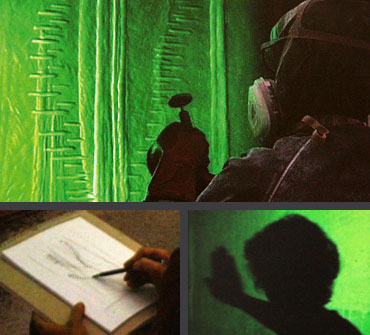Glass Etching
Once the glass has been poured and has slowly cooled down, the next step is etching. Marianne Altmaier took on the task of the etching process.
 A motif arises through dialogue with a glass panel. Marianne Altmaier etching the design in the iron-green glass panel. The glass panels are first taken out of the horizontal and set up vertically on a wooden easel. The surface is ground using a rotating diamond grinding disc, while water constantly courses over the panel. This process makes the glass - no longer transparent - more substantial and present, and the silent counterpart of the observer.
A motif arises through dialogue with a glass panel. Marianne Altmaier etching the design in the iron-green glass panel. The glass panels are first taken out of the horizontal and set up vertically on a wooden easel. The surface is ground using a rotating diamond grinding disc, while water constantly courses over the panel. This process makes the glass - no longer transparent - more substantial and present, and the silent counterpart of the observer.
The objective of the next step is to enable the glass to "speak" - to give its colour and metal expression.The glass substance is removed very carefully, and lighter areas and nuances of colour, which change in appearance depending on the time of the day, arise: the coloured light-permeated glass begins to come alive.
The removal of glass substance allows light a passage through the substance, giving the etched structures a non-material light quality. Marianne Altmaier described this dematerialization process as a potentizing process that intensifies the forces of the metal colours.
Etching also gives the glass panel a rhythmical quality. Indentations alternate with glass surfaces, horizontal meet vertical surfaces, round surfaces meet straight: rhythms arise. The coloured glass begins to "breath" and "pulsate". Etching upright and curved forms create calming or stimulating gestures, and a motif - the "spoken word" of the colour and metal.
Working in this way, Marianne Altmaier gradually developed an organism of 12 different metal colour light glass panels with 12 basic motifs.
